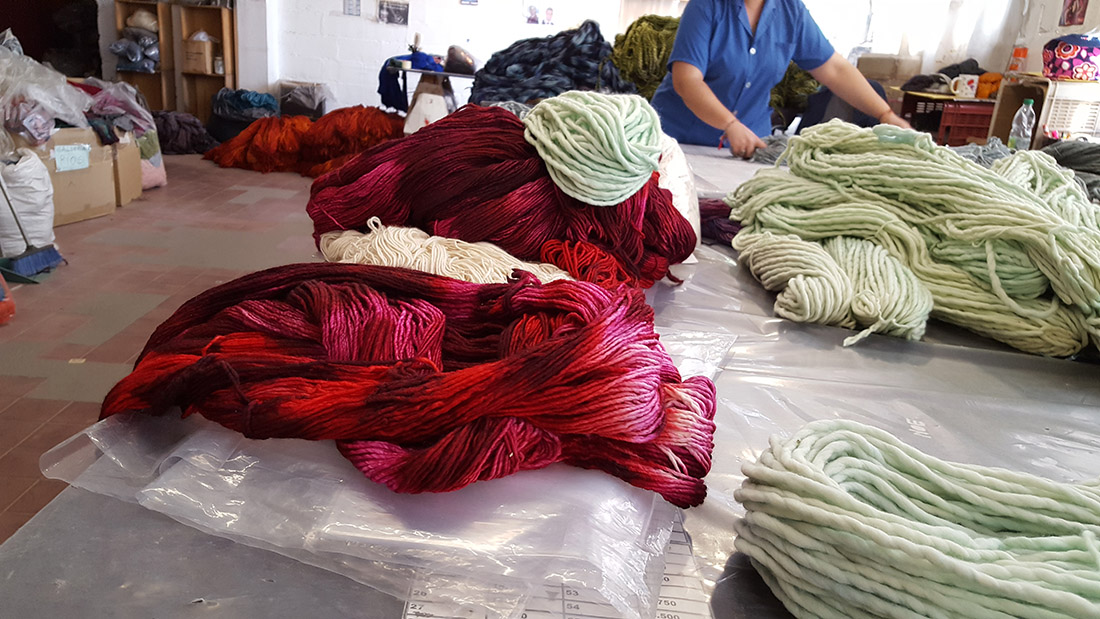
Rewind back to 2005 when the small, Uruguayan-based yarn company probably couldn’t have guessed it would become such a huge player in the English-speaking yarn world. The company began with two brothers-in-law dyeing skeins of locally-spun yarn in a kitchen kettle. After selling a small number of skeins in the United States, the company’s popularity quickly skyrocketed. And the rest, as they say, is history.
Today, Malabrigo is well-known to (and coveted by) knitters and crocheters around the world. It is one of the few companies that has successfully executed hand-dyeing on a massive scale — something typically done by small, independent and one-person operations.
A favorite of independent designers, the company has skillfully walked the razor-thin line of artisan production and ‘big yarn company’ distribution. Eagerly accepting an invitation, I visited Malabrigo at their facility in Montevideo, Uruguay, to see how it’s done.
Back to Basics: About Yarn and Hand-Dyeing
For readers who aren’t immersed (pun intended) in the world of dyeing and yarn, let’s set the stage for how those skeins of yarn come to be. Yarn is made from fibers that have been spun together into a stable strand that can be used for knitting, crocheting, or weaving. Although wool might be the most quintessential fiber (and is even more well-represented in the hand-dyeing segment due to its color-absorption properties), yarn is also made from a variety of animal fibers like llama or angora, plants like cotton and linen, and synthetics such as acrylic.
Typically, white or bleached fibers are spun into what is called a ‘yarn base,’ ready for dyeing. A commercially-dyed yarn is a yarn that has been dyed on a large scale, and these yarns are renowned for their consistency in color which is achieved through various processes.
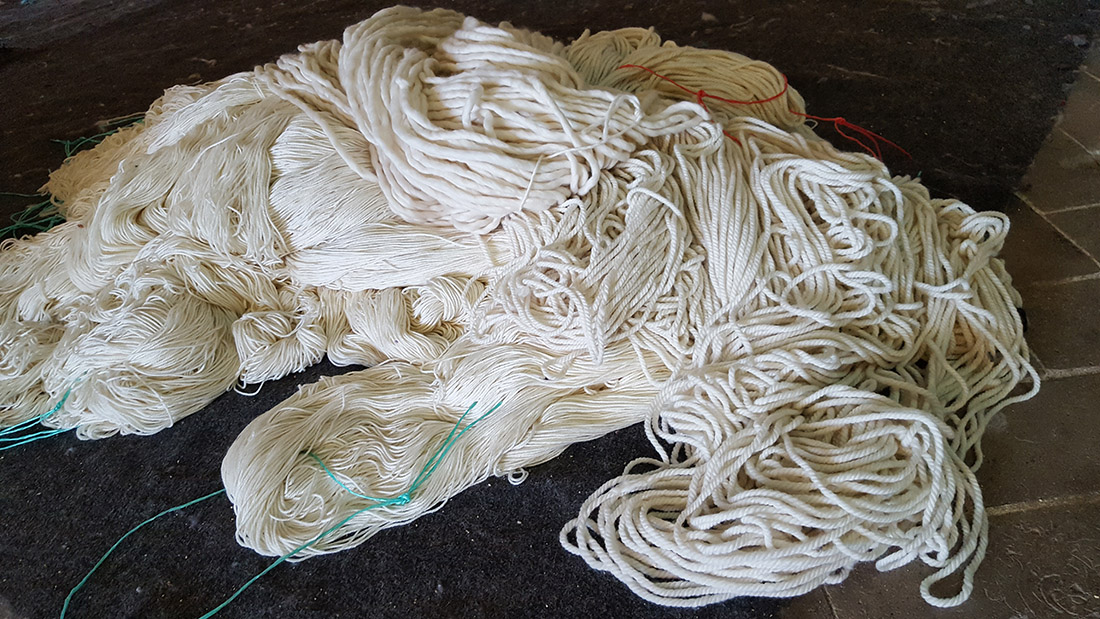
White or bleached fibers are spun into what is called a ‘yarn base,’ ready for dyeing.
Photo courtesy of Stacey Trock
Hand-dyed yarn is exactly what it sounds like: a skein of yarn is dyed by hand, often using multiple dyes or multiple dips into the dye pot. This labor-intensive and hands-on process results in colors with extraordinary depth and subtle color variation and intensity. ‘Kettle-dyed’ yarn is another name used to describe this process because these yarns are usually dyed in a giant kettle.

Hand-dyeing large quantities of yarn is hard labor. To achieve the rich, deeply tonal colors, skeins must be put into scalding hot water, picked up (wet yarn is heavy!), repeated if necessary, and then dried and skeined — twisted into the beautiful package you see in shops. All by hand.
About Malabrigo’s Yarn
Given the difficulty of hand-dyeing, it’s no surprise that few companies pull off producing such labor-intensive yarns in high quantities. And it’s no wonder such yarns command a higher price tag than commercially-dyed yarns. Because of the labor cost involved, hand-dyed yarns are typically reserved for high-quality yarn bases. Madelinetosh, Anzula, and Lorna’s Laces are examples of companies who also produce hand-dyed yarns in scale.
All of Malabrigo’s yarn comes from Uruguayan sheep, which are known for their high-quality, soft wool. The climate in Uruguay is favorable to sheep-rearing, as is the excellent pasture land (read more here: http://www.wool.com.uy/). With the early import of Merino-type breeds, a significant amount of sub-24 micron wool is produced. Microns are a measurement of the thickness of a wool; the lower the number, the finer and softer the fiber. There is now a growing amount of superfine Merino wools (less than 19.5 microns) becoming available.
Even though there is a rich wool culture in Uruguay, there are very few international yarn companies based in the country. Upon inquiring why, I was told that the amount of space required for processing and meeting the laws and regulations of the country are a great expense to starting a company in Uruguay. Furthermore, establishing a robust network of local suppliers that can provide consistent and high-quality product on a regular basis is a logistical challenge not for the faint of heart. The fiber used for Malabrigo’s yarns comes from a variety of farms, some of which feature mills that spin the bases used for dyeing.
A Peek into the Process
The process that Malabrigo uses for dyeing their yarn is surprisingly similar to the process a single person would use to dye yarn in their kitchen, except on a larger scale. To start, the yarn is received from suppliers around the country.
The yarn is then dyed in-house in kettles and dye pots. Each skein is dyed 2-3 times, depending on the colorway and desired effect. Despite operating on a larger scale, the varied, kettle-dyed coloration cannot be achieved any other way than dipping skeins of yarn into dye in small batches, by hand.
Once the yarn is dyed, it is hung in a heated drying room. This can be a potentially energy-intensive process, but the company has taken measures to ensure the energy used is as sustainable as possible. Once dry, the yarn is taken to the sorting room — a room flooded with natural light — which is necessary for accurately viewing the colors of yarn.

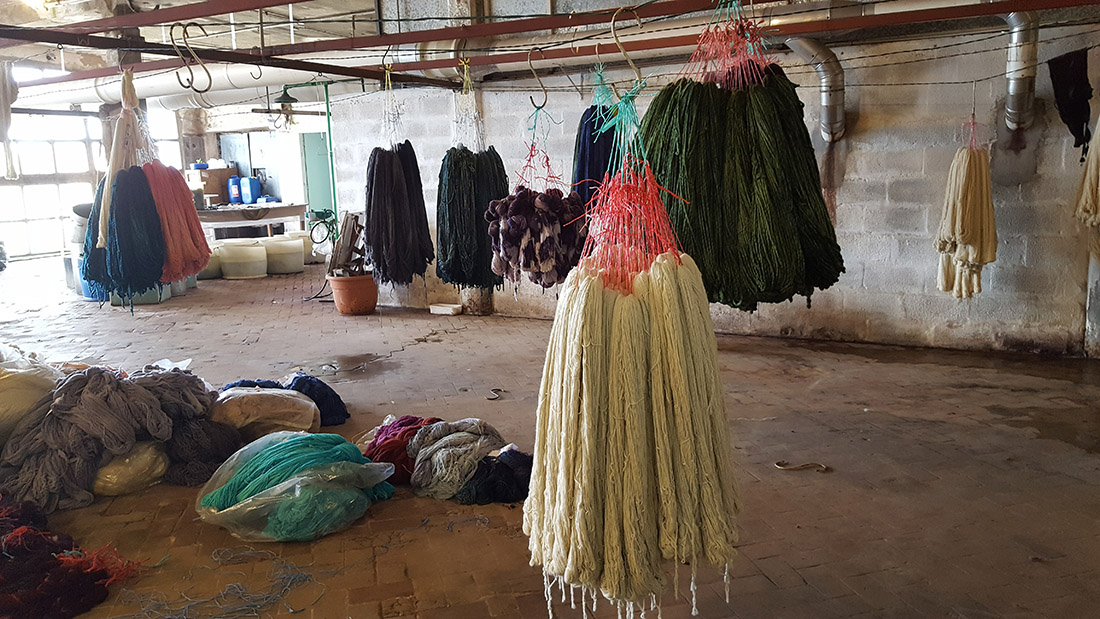
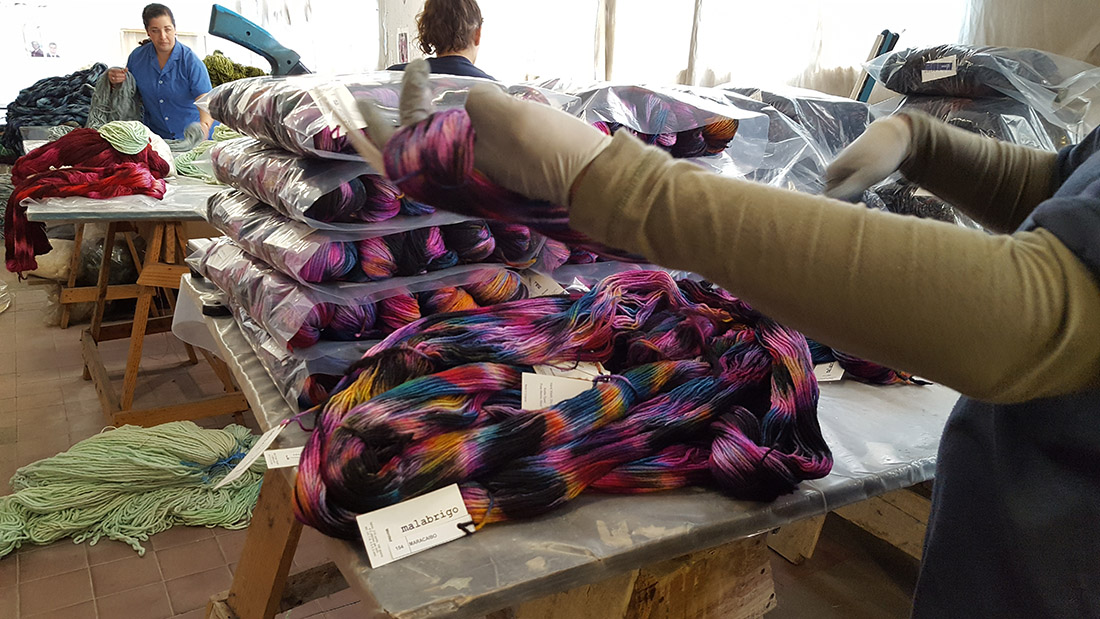
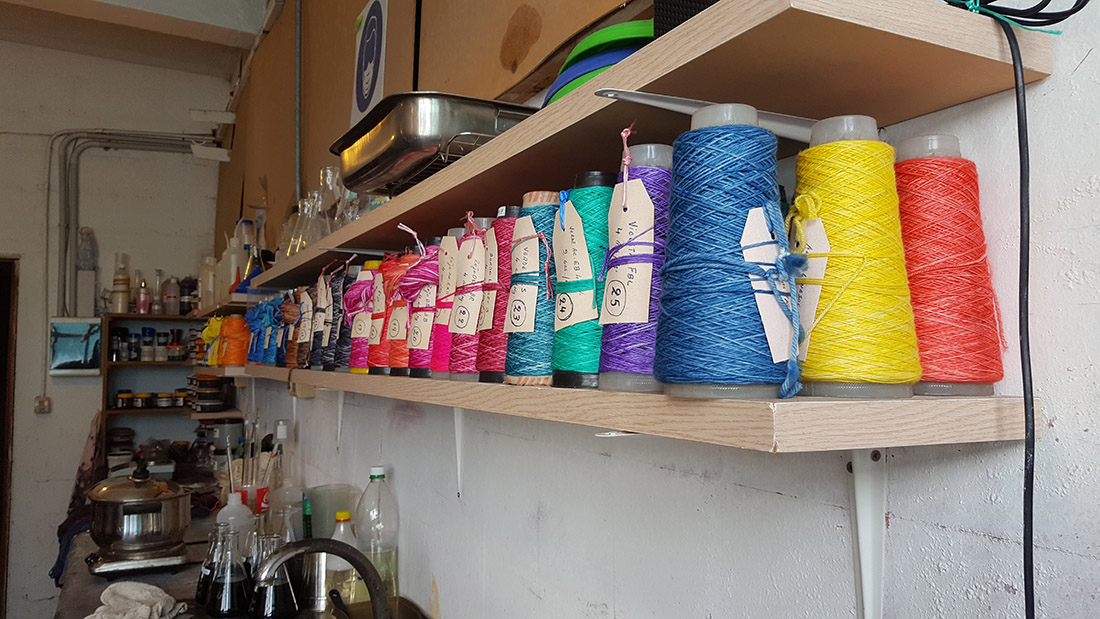

Producing Yarn for Export
Almost all the yarn Malabrigo dyes is exported out of Uruguay, and by and large, out of South America. The yarn is typically too expensive for the local market because it is so labor-intensive to produce. The local market is dominated by acrylics and lower-cost yarns. Only two shops in Uruguay sell Malabrigo, and these are high-end shops that cater to tourists.
Although I didn’t have the chance to visit yarn stores in Uruguay, I visited the yarn district in Buenos Aires in neighboring Argentina. I could immediately notice the difference between the local offerings and Malabrigo’s selection. In your average Argentinian yarn store, a typical skein was acrylic and sold for about $1.00 – $3.00/skein. Contrasted with Malabrigo skeins nearly 10 times the price, it was clear that hand-dyed, sumptuously soft wool skeins were a niche market.
At the time of my visit, the company was preparing for two large shipments to go out: one to the American distributor and a second to Australia. Malabrigo also has a significant presence in Europe and a cult following in Japan. Knitters in these markets appreciate the amount of labor that goes into hand-dyed skeins so hand-dyed yarns fetch more per skein than commercially-dyed yarns, and they have disposable income and are familiar with the demands associated with using a luxury yarn. At Malabrigo, educating the consumer about why a merino yarn pills or why they need to hand-wash a yarn is part of the company’s work.
A Focus on Sustainability and the Local Environment
The company focuses on supporting Uruguayan farms and mills as well as hiring local workers. The facility employs 20-25 people, mostly Uruguayan women.
Malabrigo acquires its wool from free-range sheep, shepherded in the traditional way on Uruguay’s lush pastureland. Mulesing — the controversial practice in which a sheep’s skin is cut to prevent a fly infestation — is not practiced.
Additionally, the company is dedicated to being environmentally-friendly when it comes to energy use in the facility. On my visit, I saw stacks of undyed wool sitting next to stacks of wood pellets. Why pellets? It turns out that the wood pellets are used for heating and are an environmentally-friendly option. The pellets are composed of waste wood and contain no chemical binders. This is in addition to the solar panels that collect energy and reduce their overall environmental footprint.

Wood pellets are used for heating and are an environmentally-friendly option, containing no chemical binders.
Photo courtesy of Stacey Trock
Continuing to Evolve
Much known for its success, Malabrigo isn’t resting on its laurels. On my visit, I was introduced to TriBeCa, a new palette of pastel colors. While a new line of colors may seem insignificant, developing pastel shades requires a completely new dyeing process from the company’s existing saturated tones.
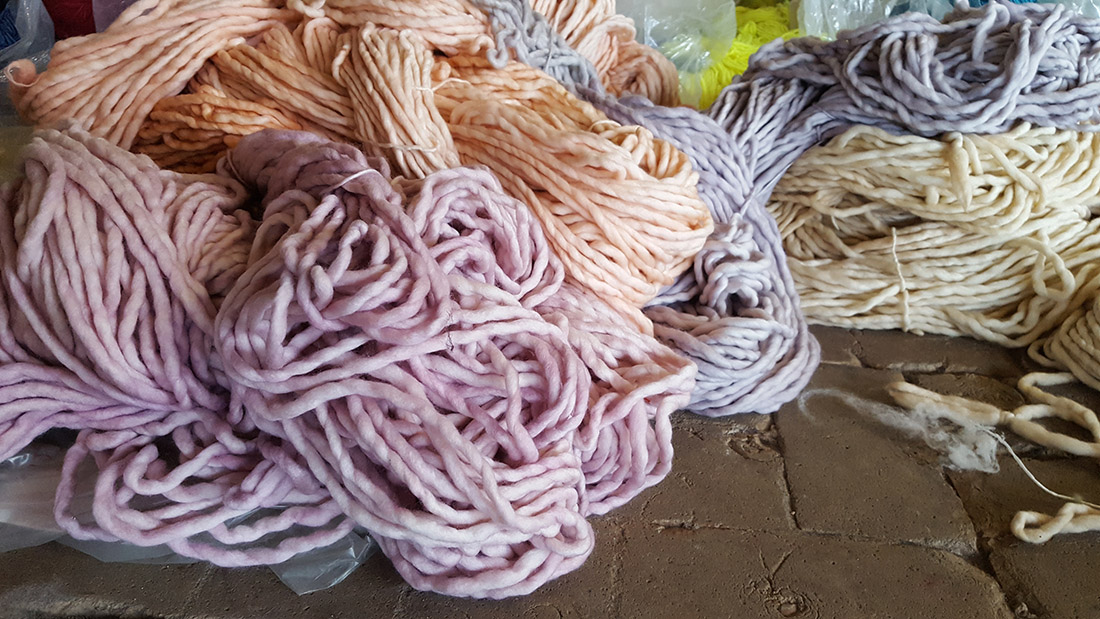
New pastel shade of TriBeCa Yarn.
Photo courtesy of Stacey Trock
Visit
Anyone is welcome to visit Malabrigo simply by contacting the company to schedule a time. The facility hosts dozens of groups a year, including visitors from a variety of knitting-themed cruises. Groups of 15 or more people can arrange a group activity to dye their own skeins of yarn.
Montevideo, Uruguay, has an international airport, and is a convenient 2 ½-hour ferry ride from Buenos Aires, Argentina. Spanish is the language spoken in Uruguay, although the owners and managers at Malabrigo also speak English. The facility is located in Parque Tecnológico Industrial del Cerro, an industrial park on the outskirts of town. It was an approximately 15-minute taxi ride from Old Town Montevideo.

Stacey Trock
contributor
Stacey Trock helps small businesses in the craft industry put their best foot forward in the digital world. She specializes in developing a company’s branding, marketing + social media to build customer-loyalty, community-building and engagement. She writes, teaches and consults on a variety of small business marketing topics.

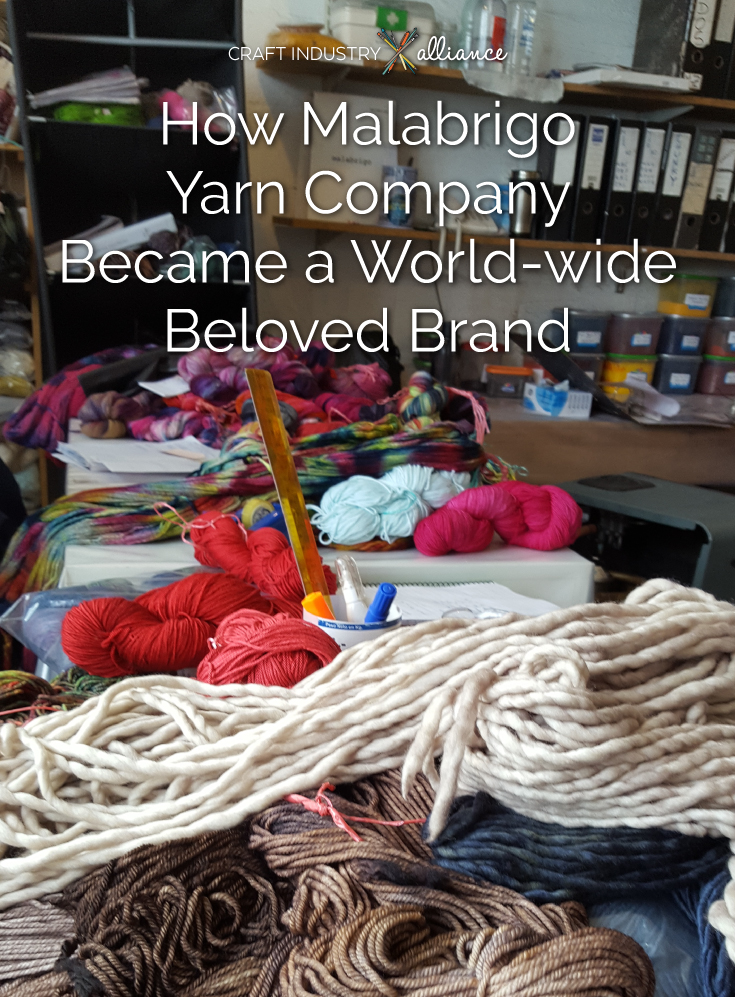
Great article Stacey, informative and interesting.
I love Malabrigo and now I understand why it is so pricey…and so worth it! Thanks
Back in the 80s I purchased a sweater and ruana from Manos del Uruguay when in Montevideo for a conference (worked at the US Embassy in Bolivia at the time). I LOVE them, and I LOVE Malabrigo. Now I want to go back and visit the factory…must buy lottery tickets. In the meantime, thanks for this article for a vicarious visit. I too love Malabrigo and am willing to pay the price for a yarn that will wear well AND supports the women who work there. Sarah Ann Smith.
Thank you so much for this article; I enjoyed it a lot. I had always wondered about the meaning of Malabrigo…in Mexico, abrigo has the meaning of raincoat, so I was surprised to learn the Uruguayan meaning!
I ❤️ Malabrigo yarn and Stacey Trock! Her Woodland Animals class taught me how to crochet. Now I am a crochet instructor myself! I just bought 4 skeins this weekend of Malabrigo Rios in Ivy for a sweater. I can’t wait to get started with it even more now that I read this article!
Hi I’m from Toronto, Canada and I have heard of Malabrigo Yarn but I have never seen it sold In any of the yarn stores in Toronto, Canada. If you know of any places in Canada that do sell it I wouldn’t mind visiting their website. Thank you.
Looks like Malabrigo has a store locator: http://www.malabrigoyarn.com/locate-10?ctco=CA&guid=1#.XiyNWhNKiqQ
Thank you for this interesting and educational piece. I have found many wonderful hand dyed wools in colorways that are particularly appropriate for men’s clothing, especially the non-earth-tone combinations. Much more interesting than many non-indy color combos.
Thank you for the article. Malabrigo is my favorite yarn. The colors are brilliant. The yarn has such a luxurious feel. It knits very well. I have never had a problem with their yarns. I just love it!
I am a professional Fiber Artist and knit a collection of scarves in Caracoal and Rios. Malabrigo yarns are top quality and worth the price. In an industry with many venerated old brands are closing shop it’s refreshing to see aduccess story. Love reading the backstory.
However, I have a lot of Rios that has tangled up as I tried to carefully wind off the skeins into cake balls. The LYS who sold them to me had to sit for 2 hours (with a dog gross) and it finally wound into about 4 little balls. A lot of loose ends and knots. I have had this in 3 different shop and at home all with tangles. Frustated.
I purchased my first lot of malabrigo recently [ 15 balls of rios] and also experienced a long, slow rewind into balls. 3
hours later I had my first ball wound, intact Yay! The second skein ended up very tangled and in 4 little balls. Not the desired result.
The following night I tried something different: I placed a round plastic tub upside down on the floor in front of me
and draped the skein over the tub so it was encircling it completely. I then proceeded to wind to effortlessly wind
the skein into a ball. Each skein took only a few minutes and there were no joins whatsoever.
Malabrigo knits like a dream!
I have used my knees, two chairs and a table-mounted swift. Oh yes, also around my laptop (it wasn’t the best one, but I was too lazy to get up). With all of these methods I never had any problem (I made a long hooded cardigan so it took 12 skeins). The trick is to make sure all the threads are not tangled in the skein to begin with. Comb them with your fingers as much as possible and make sure the starting thread is on the outside. With this short preparation, the rest of the operation goes very smoothly and quickly.
Love Malabrigo yarns. Thank you for insight into their dying process.
Would like to visit someday!
I agree that Rios is a soft yarn that comes in beautiful colors. On the down side I knitted a blanket using 32 hanks of Rios
A very educational read! I love that I am able to support small businesses in South America buy buying their wonderful products. Malbrigio (I was always wondering at that name until now – lol) really produces an unparalleled product that is a joy to work with. And I now know that they are environmentally conscious as well! Brava!
It’s interesting that no mention was made of a crucial decision that propelled Malabrigo to the top.
Years back, Malabrigo’s policy as a company was only to sell to LYS, i.e. brick and mortar. As a small yarn store online only business, this used to frustrate me to no end. I knew and loved the yarn but was unable to sell it. Somewhere around 2015, Malabrigo’s policy changed to include online only shops for wholesale accounts.
It was a game changer for my business certainly, but also for the astonishing growth they’ve seen.
Your yarn is amazing. I purchased 6 skeins of Rios a couple of years ago. I stashed because I didn’t have right pattern. I found a new pattern a couple of weeks ago. I was short a skein. I ended up ordering 2 from 2 different stores. The color blend was indistinguishable from original 6 skeins!!!!
If I understood well you were able to find 2 more skeins similar to the previous 6. If this is correct i am curious… from my experience this is almost impossible!
Sometimes i have differences even in the same store , bought at the same time
Back in the beginning when Malabrigo sold directly from their website and later on Ebay, the owners’ gregarious and attentive interaction with customers and prompt shipping became the talk of the big Knit List on Yahoo Groups. It’s good to see they’ve kept the fine quality and many of the original colorways. And the price of their flagship merino hasn’t wandered far from $11/200 (220?) yards we paid back then.